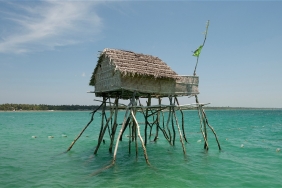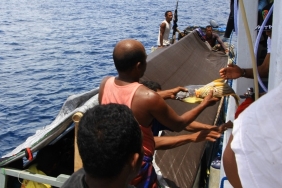THE SEA TURTLES THREATS IN SOUTHEASTERN TIP OF SULAWESI ISLAND
Turtles are a species with a very wide range of capabilities, at least almost all coasts in Indonesia are certain turtle migration routes. One of the locations of turtle migration routes or ranges is the Buton Strait and the strait between Muna Regency and South Konawe Regency. The mapping of the route was done by satellite tagging a leatherback turtle (Dermochelys coriacea) that visited the nesting beach there (RAN Turtle Conservation, 2015). However, so far, fishermen and communities in Muna Regency have only seen and interacted with other sea turtle species such as Hawksbill Turtle (Eretmochelys imbricate), Green Turtle (Chelonia mydas), and Olive Ridley Turtle (Lepidochelys olivacea).
According to the International Union for Conservation of Nature red list (IUCN, 2007), sea turtles are categorized as critically endangered. The highest threat to sea turtles is caused by two things, namely the threat of poaching and bycatch. In Indonesia, there are 6 species of sea turtles that have experienced a high population decline. As one of the Endangered, Threatened and Protected (ETP Species), sea turtles in Indonesia are protected by Law No. 5 of 1990 concerning Conservation of Biological Resources and Ecosystems and Law No. 31 of 2014 concerning Fisheries. While internationally, sea turtles have been included in Appendix 1 of CITES (Convention on International Trade in Endangered Species), which means that sea turtles have been declared as endangered animals and cannot be traded in any form.
At the end of 2018, WWF - Indonesia conducted a survey to collect sea turtle bycatch data from fishermen, identifying perceptions and challenges in handling sea turtle bycatch by local fishermen. The survey was conducted for 15 days in several areas, including Kendari City, Konawe Regency, Muna, West Muna, and North Buton. The National Action Plan (NAP) for Sea Turtle Conservation, which was developed by KKP (Ministry of Maritime Affairs and Fisheries) in 2015, became the basis for determining the survey point locations with the potential and migration paths of these turtles.
The water area or strait between Konawe, Muna and Buton regencies is one of the turtle migration routes. Geographically, this water area is located in Southeast Sulawesi province, where the north side is bordered by the large mainland of Kendari and southern Konawe, the east is bordered by the waters of the Banda Sea and Wakatobi national park, while the islands of Muna and Buton border the south, and the bay of Bone to the west. Coastal communities in Muna and Buton regencies are generally from the Bajo, Buton and Bugis tribes. They generally make a living as fishermen and cultivate seaweed, there are also some residents who cultivate crops and gardening.
According to interviews conducted with fishermen, there were at least 156 turtles caught accidentally in 2018. The turtles that were caught accidentally were generally found in sero fishing gear. Some fishermen using gill nets also found turtles caught in their nets, although often found alive, but some were found dead. The types of sea turtles that are often found are hawksbill and green turtles. Most fishermen claimed to interact with sea turtles almost every day while at sea, either accidentally caught or turtles playing around the fishing boats, and these interactions can be found throughout the year. With the large number of sea turtle bycatch cases, it is necessary to adjust fishing gear, and increase the capacity of fishermen to conduct environmentally friendly fishing activities.





